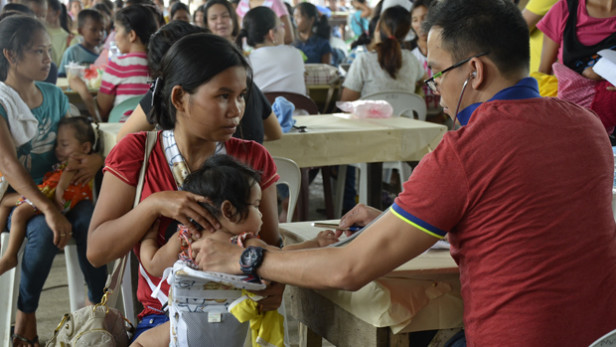Microfinance is the key for the Philippines to meet MDG 5
Devex Impact – November 18 2014
With just over 400 days remaining the meet the 2015 deadline for the Millennium Development Goals, the National Economic and Development Authority of the Philippines and U.N. Development Program recently reported the country is poised to miss achieving MDG 5 on maternal health.
The Philippine Department of Health has determined that the maternal mortality rate increased in 2011 to 221 deaths per 100,000 live births, precipitating a national call for stepping up efforts to reduce maternal mortality.

A doctor provides free checkups as part of a health outreach program in the Philippines. Photo by: CARD MRI
We believe that microfinance, with its tremendous reach, can be an important part of the solution. Integrating health and microfinance has proven both relatively inexpensive to implement and very effective in improving knowledge and changing behaviors of microfinance clients.
With the generous support of Johnson & Johnson, the Microcredit Summit Campaign, Freedom from Hunger and CARD MRI are taking on this challenge. We are collaborating on a cross-sectoral program called “Healthy Mothers, Healthy Babies,” which leverages the reach of the microfinance sector to deliver vital health education and services in the Philippines.
By the end of 2015, we will educate at least 600,000 of CARD’s clients on maternal health topics delivered through their microfinance groups. Additionally, we are establishing a partnership with other microfinance institutions and health care providers to offer access to health care services through community health fairs. This program will help to improve maternal health by promoting safe deliveries and reducing preventable maternal deaths.
In 2012, the Microcredit Summit Campaign and Freedom from Hunger established the Health and Microfinance Alliance to expand the practice of integrated health and microfinance globally. Across the world, organizations providing microfinance services (MFIs, NGOs and others) reach some 204 million people, including 116 million people living on less than $1.25 a day (the “extreme poor”). Nearly 75 percent of all microfinance clients (and 83 percent of the extreme poor) are women.
These families — especially the extreme poor — are just one illness away from losing everything, and the microfinance sector is a valuable platform for delivering health care services to them. To start, most clients participate in the group microfinance model, meeting with their group at least once a fortnight. This has shown to be an ideal venue for health education, which builds upon existing trust and the solidarity of the group.
In an integrated model, microfinance providers also work to establish links to health care providers, negotiating special rates for their clients and families, organizing health fairs (or camps) for clients and surrounding communities to get health screenings, annual checkups and education on various health issues. Recent studies have shown this to yield significant impacts on maternal and child health.
Microfinance is a stable, sustainable and scaled platform for providing access to health care. By working with microfinance providers, health providers gain access to new customers who are willing and able to pay for affordable and reliable health services. Public health providers can rely on microfinance providers as a reliable channel through which to communicate health messages to hundreds, thousands and even millions of people.
So who will take up this challenge of combining health and microfinance? “MFIs for Health,” a consortium of 18 MFIs in the Philippines, has come together to break down access barriers to health care for their combined 4.4 million clients and their family members — about 20 million people.
This is a model that has been proven at scale. Nearly 4 million microfinance clients in India now have access to health-related services. MFIs and local health providers in the Andes (Bolivia, Ecuador and Peru) are working hand-in-hand through communities of practice to improve the health of more than 600,000 vulnerable women and children in their countries.
Microfinance has built a sustainable delivery system that reaches millions of women living in poverty on a regular basis. By working together across sectors, we can provide improved health care, especially maternal and child care, to the woman and children of the Philippines.
https://www.devex.com/news/microfinance-is-the-key-for-the-philippines-to-meet-mdg-5-84823
